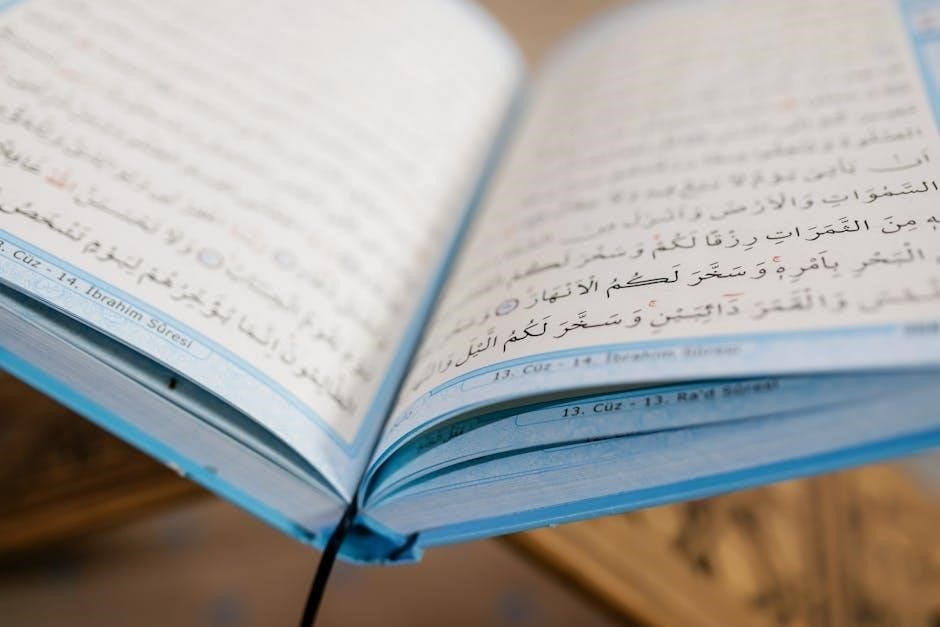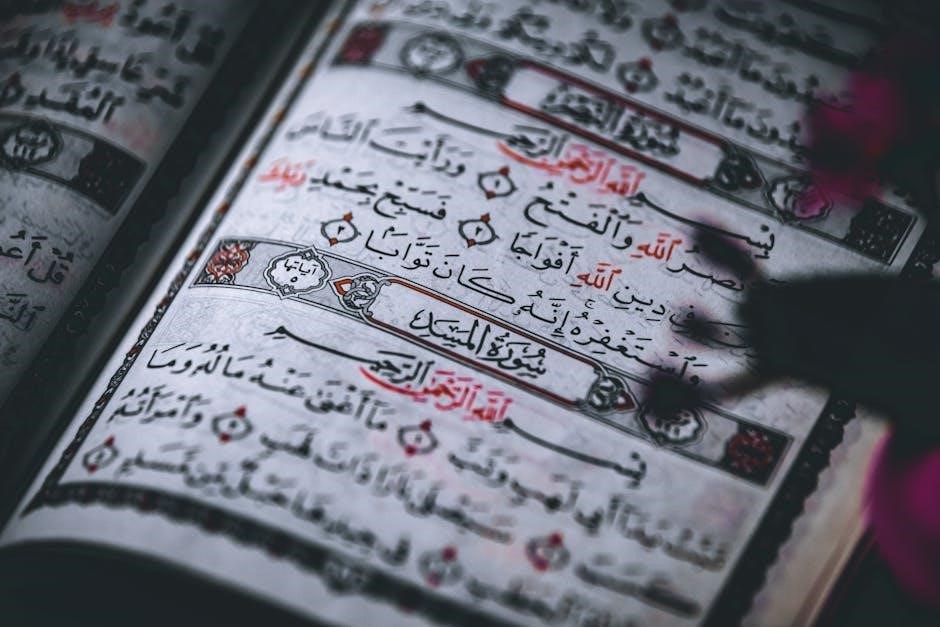The Book of Revelation is the final book of the Bible, known for its apocalyptic visions and symbolic imagery. It contains prophetic messages intertwined with vivid symbols like beasts, numbers, and heavenly scenes, aiming to convey divine truths and hopes of redemption. The book serves as a powerful conclusion to the New Testament, offering insights into God’s ultimate plan for humanity and the cosmos.
1.1 Historical Context and Purpose
The Book of Revelation was written during a time of intense persecution for early Christians, likely under Emperor Domitian’s rule in the late 1st century AD. Its purpose was to encourage believers to remain faithful despite hardships, offering hope through apocalyptic visions. The book served as both a warning and a comfort, emphasizing God’s sovereignty and ultimate triumph over evil. Its vivid imagery and symbols were meant to inspire resilience and trust in divine redemption amidst suffering.
1.2 Overview of Symbolism in Revelation
The Book of Revelation is rich in symbolic imagery, serving as a powerful tool for conveying spiritual truths. Symbols like the red beast, the woman clothed in the sun, and the Book of Life represent broader theological concepts. These symbols often carry multiple layers of meaning, reflecting divine judgment, redemption, and the ultimate triumph of God. They are designed to inspire faith and resilience, offering believers a deeper understanding of God’s plan and the cosmic struggle between good and evil.

The Number 7 in Revelation
The number 7 in Revelation symbolizes completeness and divine perfection, appearing repeatedly in visions like the seven churches, seals, trumpets, and crowns, emphasizing God’s sovereignty and ultimate fulfillment.
2.1 The Seven-Sealed Book
The seven-sealed book, mentioned in Revelation 5:1, is a central symbol representing God’s divine plan. The scroll, sealed with seven seals, contains judgments and mysteries only the Lamb can unlock. Each seal’s opening releases specific events: the first four unleash the Four Horsemen, symbolizing conquest, war, famine, and death. The fifth seal reveals martyrs crying out for justice, while the sixth brings cosmic disturbances. The seventh seal leads to silence and the sounding of the seventh trumpet; This book symbolizes God’s authority and the unfolding of His ultimate plan, emphasizing judgment and redemption.
2.2 The Seven Churches of Asia
The Seven Churches of Asia, addressed in Revelation 2-3, symbolize the universal Church and its condition. Each church—Ephesus, Smyrna, Pergamos, Thyatira, Sardis, Philadelphia, and Laodicea—represents different spiritual states. Ephesus, once vibrant, had lost its first love. Smyrna faced persecution, while Pergamos compromised with the world. Thyatira struggled with false teachings, Sardis appeared alive but was spiritually dead, Philadelphia remained faithful, and Laodicea was lukewarm. Christ’s messages to these churches serve as warnings and encouragements, urging believers to repent, remain faithful, and overcome spiritual challenges.

The Beast and Its Symbols
The Beast in Revelation symbolizes evil and opposition to God, often depicted with seven heads and ten horns, representing power and corruption, and it plays a significant role in the end-time events.
3.1 The Seven-Headed Red Dragon
The seven-headed red dragon is a prominent symbol in Revelation, representing Satan or the embodiment of evil. It is described as a massive, fiery creature with seven heads and ten horns, symbolizing power and authority. Crowns adorn its heads, signifying reigning wickedness. The dragon’s role includes opposing God and persecuting the faithful, as seen in its attempt to devour the Woman clothed in the Sun. Its red color signifies bloodshed and warfare. This creature is ultimately defeated and cast into the abyss, symbolizing the triumph of divine authority over evil.
3.2 The Beast from the Sea
The Beast from the Sea, described in Revelation 13, is a fearsome creature with seven heads and ten horns, symbolizing earthly power under Satan’s influence. It rises from chaos, embodying rebellion against God. The beast is worshiped by the world, and its power is tied to the dragon, representing evil authority. The number 666, or the mark of the beast, signifies humanity’s allegiance to evil. This symbol underscores the struggle between divine and satanic forces, warning against idolatry and urging faithfulness to God amidst persecution.

The Woman as a Symbol
The Book of Revelation features two symbolic women: the pure woman clothed in the sun and the corrupt harlot of Babylon, representing divine purity and earthly corruption.
4.1 The Woman Clothed in the Sun
The woman clothed in the sun, described in Revelation 12, symbolizes purity, strength, and divine favor. She represents the church and Israel, enduring persecution while trusting in God’s deliverance. Her attire and celestial surroundings emphasize her sacred role and connection to heavenly realms, making her a powerful and enduring symbol of hope and redemption in Christian eschatology.
4.2 The Harlot of Babylon
The Harlot of Babylon, depicted in Revelation 17, symbolizes a corrupt and oppressive system opposed to God. She represents the embodiment of evil, materialism, and sin, seducing nations into idolatry. Her fall signifies divine judgment, marking the end of corrupt worldly powers. This figure contrasts sharply with the woman clothed in the sun, highlighting the struggle between purity and darkness in apocalyptic imagery.

Other Creatures and Their Meanings
The Lamb with seven horns symbolizes divine power and redemption, while the four living creatures represent God’s attributes and judgment, as revealed in apocalyptic visions.
5.1 The Lamb with Seven Horns
The Lamb with seven horns is a central symbol in Revelation, representing divine authority and redemption. Seven horns signify complete power, emphasizing Christ’s role as the ultimate redeemer. This image is tied to the opening of the seven-sealed book, marking the beginning of end-time events. The Lamb’s sacrifice and resurrection are symbolized by its appearance, reinforcing themes of atonement and victory. Its presence in Revelation underscores hope and the fulfillment of God’s plan, making it a pivotal figure in apocalyptic imagery.
5.2 The Four Living Creatures
The Four Living Creatures, described in Revelation, are powerful symbols associated with God’s throne. They are depicted as lion, ox, man, and eagle, embodying divine attributes and creation’s majesty. These creatures continually worship God, representing heaven’s praise and divine judgment. Their multiple eyes and wings symbolize omnipresence and divine insight. They play a crucial role in the apocalyptic visions, heralding divine actions and emphasizing the sovereignty of God over all creation.

The Two Witnesses and the 144,000
The Two Witnesses prophesy during the tribulation, symbolizing God’s truth and judgment; The 144,000, sealed from Israel’s tribes, represent divine election and redemption, embodying God’s faithfulness.
6.1 The Two Witnesses
The Two Witnesses, mentioned in Revelation 10 and 11, are symbolic figures prophesying during the tribulation. They embody divine truth and judgment, clothed in sackcloth, signifying humility and mourning. Their ministry lasts 1,260 days, during which they perform miracles and condemn wickedness. Martyred by the Beast, their resurrection after three days symbolizes God’s triumph over evil. Their role underscores God’s faithfulness and the ultimate victory of truth over oppression, inspiring hope amid chaos.
6.2 The 144,000 Sealed from the Tribes of Israel
The 144,000 sealed from the Tribes of Israel symbolize God’s faithful remnant. They are chosen 12,000 from each of the twelve tribes, sealed for protection during judgment. This number, 144,000, represents completeness and divine order, emphasizing God’s covenant with His people. Their sealing signifies ownership and preservation, highlighting their role as faithful servants who stand with the Lamb on Mount Zion. They embody redemption and hope, contrasting with evil forces, and illustrate God’s triumph and sovereignty in His ultimate plan.

Objects of Judgment and Salvation
The Book of Revelation features symbolic objects of judgment and salvation, such as the keys of death and Hades and the sword from Christ’s mouth.
7.1 The Keys of Death and Hades
The keys of death and Hades symbolize Christ’s authority over mortality and the spiritual realm. In Revelation 1:18, Jesus holds these keys, signifying His power to deliver believers from eternal death. They represent His triumph over sin and the grave, offering hope of resurrection and eternal life. This imagery underscores God’s sovereignty and the ultimate defeat of darkness, aligning with the book’s themes of redemption and divine judgment. The keys embody the promise of salvation and eternal victory for the faithful.
7.2 The Sword Coming Out of the Mouth
The sword coming out of the mouth symbolizes the power of Christ’s word to judge and purify. In Revelation 2:12 and 19:15, this imagery represents His authority to discern and condemn evil. The sword signifies the sharpness of divine judgment, cutting through deception and unrighteousness. It also reflects the dual nature of Christ’s message, which brings salvation to believers but judgment to the unrepentant. This symbol underscores the transformative and redemptive power of God’s Word in the apocalyptic narrative.

The Book of Life and Final Judgment
The Book of Life records the names of the faithful, determining their eternal destiny. The Final Judgment separates the righteous from the wicked, with the Lake of Fire awaiting those not in the Book.
8.1 The Book of Life
The Book of Life is a central symbol in Revelation, representing God’s record of the faithful. It signifies divine judgment, where names are inscribed for eternal life. Those whose names are written are redeemed, while others face separation. This book is a source of hope, emphasizing perseverance and faithfulness. It underscores the ultimate accounting of souls, where righteousness prevails, aligning with Revelation’s broader narrative of redemption and divine justice.
8.2 The Final Judgment and the Lake of Fire
The Final Judgment in Revelation signifies the ultimate reckoning of humanity, where deeds are weighed, and eternal destinies are sealed. The Lake of Fire, a symbol of divine judgment, represents eternal punishment for the wicked, including Satan and his followers. This imagery underscores the consequences of rejecting God, while the righteous enter eternal life. The Lake of Fire also symbolizes purification and the eradication of evil, aligning with Revelation’s themes of justice, redemption, and God’s ultimate triumph over darkness.

The New Jerusalem and the Tree of Life
The New Jerusalem symbolizes eternal life and divine presence, while the Tree of Life bears twelve fruits, representing restoration and abundance in God’s kingdom.
9.1 The New Jerusalem
The New Jerusalem represents the ultimate fulfillment of God’s plan, symbolizing a heavenly city where believers dwell in eternal fellowship with God. Described as a bride adorned for her husband, it signifies purity and unity. The city descends from heaven, emphasizing divine origin and glory. Its cubic shape and immense size underscore perfection and equality in heaven. The absence of a temple highlights God’s direct presence, while the river of life flowing through it symbolizes eternal sustenance and renewal.
9.2 The Tree of Life
The Tree of Life is a prominent symbol in Revelation, embodying eternal life and divine abundance. Located in the New Jerusalem, it bears twelve kinds of fruit, symbolizing God’s provision and healing for the nations. Its leaves possess healing properties, reflecting restoration and wholeness. Rooted in the river of life, the tree represents the source of eternal sustenance. It also symbolizes the restoration of Eden’s paradise, where humanity once enjoyed unbroken fellowship with God. Access to its fruit is reserved for the righteous, highlighting its divine promise and exclusivity.
